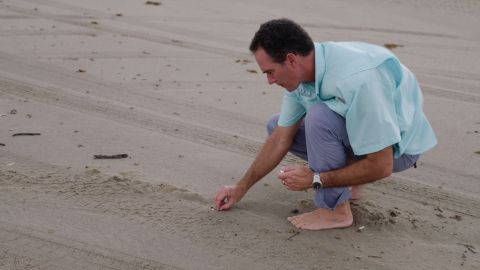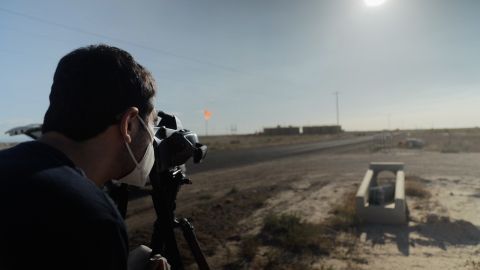Environmentalists have some unexpected allies when seeking a methane solution
Methane emissions caused by human-related activities, especially from livestock, and oil and gas industries, are responsible for 25% of global warming, according to the United Nations. Hari Sreenivasan reports on the growing call by environmentalists and the oil and gas industry to measure and curb methane emissions.
TRANSCRIPT:
Hari Sreenivasan:
There’s another climate-related issue that is likely to cross President Biden’s desk: controlling emissions of methane.
The United Nations estimates that about 25 percent of climate warming comes from the human-caused release of methane — mainly through livestock and oil & gas industries. Now, there’s a growing effort to figure out just how much methane we’re putting into the atmosphere, and what to do about it.
This report is part of our ongoing series on climate change, “Peril & Promise.”
The United States is the world’s largest oil and natural gas producer. Burning fossil fuels emits carbon dioxide, of course — CO2. But drilling also releases another potent greenhouse gas: methane. Both CO2 and methane warm the planet, but at different rates.
Ilissa Ocko:
Carbon dioxide is a major problem because it can last for so long in the atmosphere.
Hari Sreenivasan:
Ilissa Ocko is a climate scientist with the nonprofit Environmental Defense Fund, EDF.
Ilissa Ocko:
The carbon dioxide that we emit into the atmosphere today, around 40 percent of it could still be there in a hundred years from now. And so that’s why carbon dioxide is such a big problem, because it builds up over time and commits our planet to warming for centuries and for generations to come.
Methane is much more powerful at trapping heat than carbon dioxide, but it only lasts in the atmosphere for around a decade. So if you were to emit equal amounts of emissions of CO2 and methane today, you’re going to have a lot more warming from methane over the next few years than you will from CO2.
Hari Sreenivasan:
That means reducing methane emissions can have a relatively rapid effect on climate change. which brings us to the Permian Basin. spanning more than 85, 000 square miles. It includes a vast stretch of west Texas and southeastern New Mexico. Oil companies pull more than 4 million barrels a day from it.
Colin Leyden:
The Permian Basin is the largest oil and gas basin in the United States, it’s one of the largest in the world. But we didn’t have an idea — a good idea of how much methane was being emitted by the operations there.
Hari Sreenivasan:
Colin Leyden is EDF’s Director of Regulatory and Legislative Affairs.
Colin Leyden:
So we put together a comprehensive science measurement program to locate these methane emissions, as well as get an idea of how much of this is escaping into the atmosphere.
Hari Sreenivasan:
For more than a year, using everything from mobile labs and cell phone towers to aircraft and satellites, EDF has been working with colleagues from the University of Wyoming, Penn State University, Scientific Aviation, and others to document methane release in the Permian Basin.
How do you actually see it, so to speak? I mean, natural gas doesn’t — it’s like iocane powder from the Princess Bride, odorless, colorless, whatever. And so how do you — how do you actually see the emissions that are escaping?
Colin Leyden:
Fortunately, there are infrared cameras that can pick up and detect the emissions so that you can see them.
Hari Sreenivasan:
This tower is called a flare stack. And it looks to the naked eye like nothing’s coming out of it. but, here’s what the infrared camera sees: methane is going straight into the atmosphere. It’s a practice called “venting.” EDF has documented scenes like this across the Permian Basin.
Sometimes venting happens legally, with a permit. Other times it’s illegal, even accidental, when a flare stack is simply operating improperly. When a stack is working like it is supposed to, it burns the methane in a process known as flaring, which can also be done with a permit. Sometimes the camera catches venting and flaring side by side.
So when we see those images of a pipe and a flame glowing at the top of it, that’s flaring what’s actually happening there?
Colin Leyden:
That’s burning off excess gas, that could be happening for various reasons. There could be a true health and safety reason, maybe an over-pressurized system, you know, where they need to flare. But oftentimes what we’ve been seeing in the Permian Basin over the years has been just simply flaring for convenience.
Hari Sreenivasan:
EDF publishes its results at a site called Permian Map. They say their surveys have found 5 percent of the Basin’s flare stacks going completely unlit, and venting gas, and an additional 6 percent malfunctioning to some extent.
The EDF group estimates that methane is leaking from Permian oil and gas facilities at three times what the environmental protection agency estimates — that comes to about 2.7 million tons of gas a year. it’s not surprising then, that a call has gone out for serious reductions in methane emissions. and it’s not just from environmentalists and scientists.
Private and institutional investors managing some $ 2 trillion in assets — even the World Bank — have called for an end to routine flaring of methane.
Erin Blanton:
I mean, there are things that the investment community can do.
Hari Sreenivasan:
Erin Blanton is a senior research scholar at the Center on Global Energy Policy at Columbia University’s School of International and Public Affairs.
Erin Blanton:
Something very simple would be just a commitment to stop routine flaring by, for example, 2025. That’s a fair amount of time. It’s a practice that is wasteful. It wastes money. There’s no revenues that come from flaring the gas. And the investment community could say we won’t invest in companies that practice routine flaring. You know, we will not lend to them.
Hari Sreenivasan:
If that sounds pie-in-the-sky, consider this: recently a French investment concern cancelled a $7 billion deal to buy liquid natural gas –LNG — coming from the Permian. POLITICO reported there was pressure from the France’s government to not source their gas from a place that does not have methane pollution under control. But if there seems to be a growing consensus favoring tougher regulation, there are obstacles as well.
Last summer, President Trump rolled back Obama-era regulations and made it easier for oil producers to keep flaring and venting methane. Then there’s the Texas Railroad Commission. It has the oil and gas industry under its authority. It’s charge, it says, is to protect citizens, the environment and the economy. But in Texas, it has long been a friend to the fossil fuel industry, and gone easy on gas flaring.
In November, the 3-member commission did release new rules strengthening requirements to obtain methane flaring permits but fell far short of what its critics say is necessary. That same month, a new commissioner was elected, Republican Jim Wright. On a podcast during the campaign he appeared unaware of the science around methane emissions.
Jim Wright:
Can you tell me of any exact research that really says that flaring is actually harming our atmosphere any worse than emissions from a car or anything else that they’re claiming is making changes to our climate that we see today.
Hari Sreenivasan:
The Biden Administration is taking the opposite tack. The President has plans to, quote, “take actions including requiring aggressive methane pollution limits for new and existing oil and gas operations.” And it sounds like he might have what once would have been some unlikely allies. When President Trump rolled back those methane regulations last year, even some energy giants pushed back, including BP and Shell.



